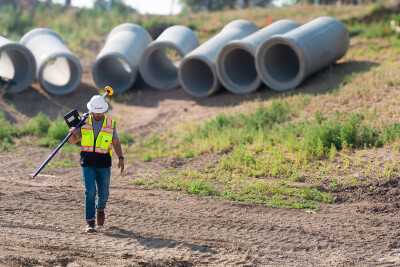The reputation that the construction industry, and the AEC sector more broadly, has held with regard to technological adoption is no secret to anyone working within or adjacent to these spaces. The industry, traditionally, has been slower to adopt new tools and more averse to taking risks around technologies, trends that reached an apex nearly a decade ago when McKinsey released their now infamous report, Imagining Construction’s Digital Future. Many would argue that reputation was never entirely earned – at the very least, it was exaggerated – but the extent to which it was true a decade ago is no longer relevant. Today, construction firms are very much embracing new tools, even if it’s simply out of necessity.
As we continue to look ahead to what’s to come for this industry with respect to its thoughts and approaches to technology, it’s less about whether or not they will adopt these tools, but about how firms are thinking about navigating the current landscape defined by a shrinking workforce and growing demand.
To talk through this, Geo Week News spoke last month to Sasha Reed, the senior director of industry transformation with Procore, about what she sees as the defining trends for the industry in the coming year. It’s a similar conversation to one we had with Reed last year, where she discussed the transition from digitization to digitalization – or moving from simply using digital tools to allowing it to transform business processes.

Broadly speaking, Reed only sees this trend continuing in 2025, and at an increasing pace. In fact, she calls 2025 the “year of exponential,” when we’ll start to see firms rapidly embracing and utilizing digital tools to improve their workflows. Below, you can find three specific areas where she really sees this “year of exponential” coming through.
Education Takes Center Stage
It’s no secret that construction firms are struggling to fill out their workforce to cleanly meet the demand for projects across sectors right now. Some of this can be addressed with new technology to be sure, but that is a bit of a band-aid solution to an existential problem. Long-term, these firms need to find a way to both attract new talent into these trades and re-skill their existing workforce to better fit into modern workflows in order to truly maximize their efficiency.
With this in mind, the first category of trend for 2025 Reed mentions is that contractors are starting to become educators. From her work alongside many of Procore’s customers, she is seeing that contractors are recognizing the need not only for up-skilling but also for re-skilling. She notes that in some parts of the United States, local trade union apprenticeship programs have long wait lists, showing that there is real interest among both young people and mid-career folks looking for career pivots in the trades. As a result, she is seeing contractors starting to create their own training programs.
“Some contractors are starting to create their own pre-apprenticeship trade training programs,” Reed says. “And the beauty of what we're seeing is that the training programs are also inclusive of technology and some of the skill sets that these contractors recognize they're going to need in that graduating class.”
There are, of course, complications for this, with time probably being the biggest one. The issue in the industry is not having enough workers for the projects they have, so finding the time for this kind of training is easier said than done. However, those who find a way will benefit, and solve probably the biggest issue in the industry – the labor shortage – by, in Reed’s words, “becoming educators and developing the education pathways into the trades that's getting both young people and mid-career pivoters into those programs with the right set of skills.”

Bringing In Outside Perspectives
For any individual company or even a team within a company, it’s always important to infuse fresh perspectives into workflows. Otherwise, you risk missing important trends and simply sticking with long-established habits that could theoretically be improved. There’s no reason those same principles wouldn’t also apply to an entire industry like construction. Reed says that she is starting to see these outside perspectives coming into the industry, and the firms that are hiring these outside voices are and will continue to reap the benefits.
She explains that many of the firms she speaks with continuously see their year-over-year revenues growing, but the bottom-line profit isn’t necessarily improving. From the technology side of the coin, she says, this largely comes down to a productivity gap and how contractors operate businesses.
“Most executives in construction know construction,” Reed says. “But they don’t necessarily know business. The firms that we’re seeing who are operating differently are bringing on board individuals who may not come from construction, but who know business.”
As a result, these executives – whether they come in as a CFO, VP of Innovation, or some other similar title – are finding new ways to embrace digitalization and find low-hanging fruit to streamline efficiencies. For example, she points to one survey that found only one in seven construction businesses have access to daily insights on projects, meaning they’re only seeing issues once workers are already reacting to them. Firms that recognize the inefficiency here are using these insights to allow people to be “reapplied to the business in more meaningful ways, to apply their construction knowledge to the data that’s coming in and really starting to move that bottom line up.”

Data-Driven Companies Will Come Out Ahead
We know that every industry in the world is reckoning with how they can best utilize new artificial intelligence capabilities for their workflows, and construction is no exception. Every firm is taking this transformation at its own pace, but Reed believes that those who leverage their data the best are going to be the ones that come out ahead.
To make that point, she looks at the worldwide trends around spending for artificial intelligence across all industries, noting that about two-thirds of all AI spending for the coming year is expected to go into core business operations. She sees construction following the same path as other industries in this instance – a stark difference compared to other technological trends in decades past – which makes her excited that the industry is moving in the right direction.
“Last year, I think people were asking what AI is and how they can best apply it,” Reed notes. “Now, we’re going to start seeing the leaders pull away from the pack a little bit in figuring out that application, and that’s going to have a rapid impact.”
While these three trends each cover different areas – education, business processes, and artificial intelligence – they all fall under a similar umbrella around where the construction industry is today. It’s no longer the technological laggard. It’s an industry that is adapting to the world around them, leveraging cutting-edge tools, and using it all to take a big step forward in efficiency. According to Reed, this is the year these trends seem to be coming together, with the leaders separating themselves and the industry as a whole moving forward exponentially.
“Last year I said the biggest question [around new tools] was, What is it and how does it help me? That question has started to get answered in a span of one year,” Reed says. “These are the tipping point moments I think we’ve really been waiting for in the industry to see the uptake in really meaningful ways. It’s going to have the net positive impact that we’re hoping for.”






